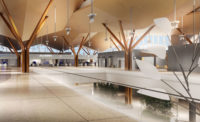The failure of the world’s largest engineered slope a year ago at Charleston’s Yeager Airport has generated widespread speculation from the international engineering community because of the scale of construction and the numerous prizes for design the project had garnered, says Chrys Steiakakis, a geotechnical engineer at Geosysta Ltd., Attiki, Greece. Steiakakis, who has a master’s degree in engineering from Virginia Tech, hosted an American Society of Civil Engineers online forum that has received comments on the incident from more than 100 engineers around the world.
Once praised for innovation, the project designer and contractor now face a lawsuit brought by airport officials. In a West Virginia circuit-court complaint, the airport accused designer Triad Engineering and general contractor Cast and Baker of gross negligence of an extremely “willful wanton and reckless nature,” showing gross indifference to the warning signs that precipitated the fail and defying “their obligations in pursuit of profits.”
Cast and Baker asked for a dismissal of the airport’s lawsuit, claiming that the state court does not have jurisdiction because the project was regulated by the Federal Aviation Administration and funded almost completely with federal money. Triad said “superseding, unforeseen or intervening circumstances” were to blame for the catastrophic failure and denied charges of negligence and breach or warranty.
An attorney for the airport told ENR the jurisdictional dispute has stalled the case, but it has not dampened intense interest from geotechnical and civil engineers, who often learn more from failures than successes, Steiakakis said.
In order to meet FAA safety standards, Yeager’s Runway 5 was extended to create an emergency stopping apron. The engineered materials arresting system (EMAS) consisted of foam blocks sitting on a crowned asphalt bed, supported by a 240-ft-high 1:1 steepened, reinforced slope. Crews filled in the existing hillside with crushed sandstone, then used two types of synthetic meshes and grids to bind the sandstone to the hill.
The project was completed in 2010.Court documents say airport employees noticed separation in the EMAS blocks in July 2013. Triad began to monitor the site and installed motion sensors, then inaugurated a site investigation.
Engineers observed increased movement in the slope after a very wet, early spring last year. On March 11, 2015, Yeager held an emergency board meeting and was told by Triad that chances of a catastrophic failure were very slight. One day later, the slope totally collapsed.
In addition to speculation on the primary cause of the fail, engineers wonder why more preventative measures were not taken in the two-year period between the first notice of EMAS deformation and the total collapse.
“Until we know [the investigation results], it’s all just idle speculation,” says Michael Plante, airport spokesman.
Many U.S. interstate embankments were built on 1.5:1 graded fill slopes because testing on the crushed shale used as fill indicated high internal friction. “However, after years of weathering, some of these shales had friction angles as low as 20º, resulting in a lot of roadside landslides,” Tom Zannino, a Virginia-based engineer who dealt with a similar but smaller catastrophe at the airport in the 1980s, told ENR.
“The sandstone drains fairly well, but the shale is nearly impervious and causes seeps to occur along down-gradient sides of slopes. I doubt very seriously that this was a bearing-capacity failure,” Zannino said of the landslide. “It was more likely a friction issue aggravated by water.”
Last summer, airport officials hired Philadelphia-based Schnabel Engineering to develop a mitigation effort and long-term repair plans for the slope and, in late November, decided on a $20-million rebuild option. However, funding problems, insurance claim disputes and litigation have stalled the process. In any case, “The methodology that was used in the original build has been rejected out of hand,” Plante said.




Post a comment to this article
Report Abusive Comment